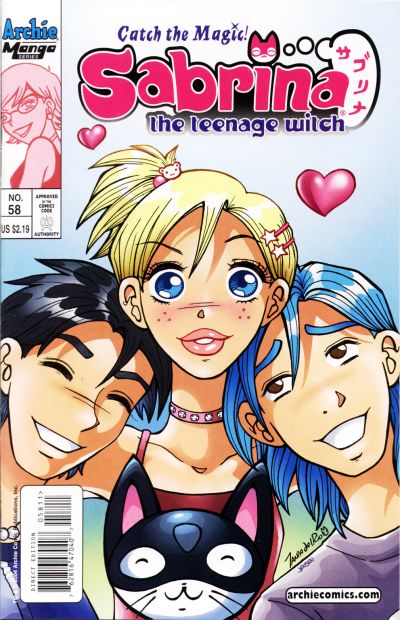Sabrina the Teenage Witch 58-100
Reviewed by Nigel Fletcher 06-Nov-10
Before Tania Del Rio became writer and artist, Archie Comics’ Sabrina title had been featuring the same sort of short stories as all of the other titles featuring the Archie Riverdale characters. The most important thing that Del Rio did was to tell a larger story over forty-two issues, something unusual anywhere, let alone at Archie.
 Before Tania Del Rio became writer and artist, Archie Comics’ Sabrina title had been featuring the same sort of short stories as all of the other titles featuring the Archie Riverdale characters. In issues 56 and 57, for instance, this included stories where the denouement hinges on the difference between “dye” and “die”, where Sabrina sees off alien tourists who she’s worried might turn her boyfriend’s head, and a practical joke involving switching a dragon’s egg for a chicken’s.
Before Tania Del Rio became writer and artist, Archie Comics’ Sabrina title had been featuring the same sort of short stories as all of the other titles featuring the Archie Riverdale characters. In issues 56 and 57, for instance, this included stories where the denouement hinges on the difference between “dye” and “die”, where Sabrina sees off alien tourists who she’s worried might turn her boyfriend’s head, and a practical joke involving switching a dragon’s egg for a chicken’s.
Ignoring the question of “manga” for the moment, the most important thing that Del Rio did was to tell a larger story over forty-two issues, something unusual anywhere, let alone at Archie.
Initial issues establish the setting and the main characters, though several important people are only introduced later (Hemlock, Narayan and Bartholemew for instance). Sabrina lives with her aunts Hilda and Zelda in the human world and attends high school there as well as attending Charm School in the Magic Realm. She’s the daughter of a human and a wizard, both of whom appear to have abandoned her.
Sabrina has a crush on Harvey, but also on Shinji, one of her Charm School friends, who also enrols at her high school for a Charm School project. Sabrina’s friend Llandra has a crush on Shinji; high-schooler, Amy has a crush on Harvey. Shinji and Harvey are both interested in Sabrina and antagonistic towards the other.
For the most part, Del Rio tells single issue stories that advance (or shuffle) the romantic pairings, tell a tale of learning (at either school) or show teenagers having fun (e.g. at Hallowe’en parties). Gradually, we’re introduced to Seles, Queen of the Magic Realm, the dying leaves of the Mana Tree, which is the source of the Realm’s magic. Then there’s the Four Blades, a group that mounted a failed uprising in the Magic Realm, which Shinji convinces the others to restart.
From a gag strip to one featuring a teenage revolutionary in twenty-two easy issues. Del Rio completes the story in issue 100, after a number of twists and turns and revelations about the past. Though a continuation would have been welcome, there’s also a certain satisfaction in reading a completed tale.
So why “manga”? Well, Del Rio’s artwork is fluid, bright and charming, helped by Jim Amash’s inking and Jason Jensen’s colouring. Del Rio doesn’t keep to six-panels per page, she’s not afraid to expand her borders. Her characters are expressive even just talking because of the manga-like expressions and body language (big eyes, shape changing, cartoon effects to display emotion, etc.).
It was hard to wait for each bi-monthly issue, and each issue was also top of the pile to read when it did arrive. No doubt there were readers who were put off by the “manga” label, but that was only a small part of what Del Rio was doing. This would not have been quite the same drawn in a different style, but it would have been a good series drawn in any style because the writing’s that good.
See also the interview with Tania Del Rio.
Tags: Archie, Sabrina, Tania Del Rio